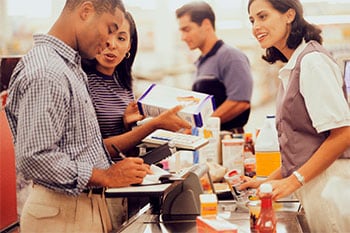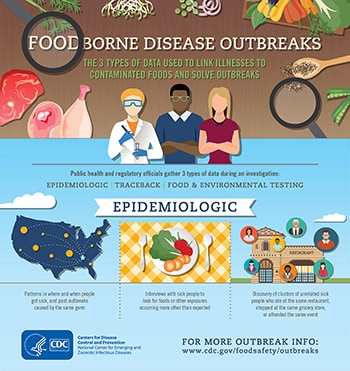You Can Help Solve Foodborne Outbreaks
Watch this video to learn how disease detectives figure out what contaminated food is making people sick during outbreaks.
Did you know you can help disease detectives find and solve foodborne disease outbreaks? Learn some ways you can help protect others from getting sick.
Foodborne Disease Outbreaks
Each year in the United States, about 1 in 6 people (or 48 million) get sick from a foodborne illness, also known as food poisoning. Many of these illnesses occur one by one, but some are part of outbreaks.
Finding the source of an outbreak is important because the contaminated food could still be in stores, restaurants, or kitchens and could make more people sick. You can help solve these outbreaks by providing vital clues to disease detectives. Keep reading to find out how you can help.
Three Ways You Can Help if You Have Food Poisoning
1. Talk to Your Healthcare Provider
Talk to your healthcare provider about whether you should be tested for a foodborne disease.
Healthcare providers can test your stool (poop) or blood, which can tell them if you have a foodborne disease. Many doctors are now using tests that give a quick diagnosis, often while you wait in the office. If this test shows that you have an infection with a notifiable disease like Salmonella or E. coli, the doctor or laboratory should order another test and send those results to the public health laboratory in your state. Results from this test, without information that identifies you, are added to a database at CDC that holds DNA fingerprints of foodborne germs. The database is part of PulseNet, a network of local, state, and federal public health and food regulatory agency laboratories. PulseNet looks for groups of similar foodborne germ DNA fingerprints for health officials to investigate. This information helps health officials determine if there is an outbreak where other people became sick from the same food item.

If you get sick, write down what you ate and what you did in the week before.
2. Write Down What You Ate and What You Did
Did you know that the food that made you sick is usually not the last food you ate? The time between eating a contaminated food and feeling sick is often 2–3 days and sometimes longer. If you get sick with food poisoning, write down everything that you remember eating in the week before you started to get sick, including restaurants where you ate or special events you attended. Write down any contact you had with pets or other animals.
Gather and save food receipts you have kept from the grocery store or restaurants.
3. Report Your Illness to Your Health Department
If you think you have food poisoning, report it to your local or state health department.
Promptly reporting your illness helps your local or state health department identify possible foodborne disease outbreaks. Health departments track reports of illnesses and look for groups of people with similar symptoms and exposures.
Disease detectives will likely interview you over the phone to find out what you ate and did in the week before you got sick. Investigators may also ask for copies of receipts or leftover food. Take the time to participate in this interview—you’ll be helping the investigation!
Three Ways You Can Help When You’re Not Sick With Food Poisoning

Keep food receipts from stores and restaurants.
1. Keep Food Receipts and Enroll in Shopper Card Programs
It’s a good idea to keep food receipts from grocery stores and restaurants for at least 2 months before discarding them. Keeping these receipts can help you remember what you ate if you get sick.
Many shopper card or loyalty programs allow you to track your purchases and can provide important information on foods, brands, and other details that can help disease detectives during outbreak investigations. Investigators only use your shopper card information with your permission.
2. Keep Food Labels
Store or freeze food with the original packaging or label. This helps identify what the food is and could help trace where it came from during an outbreak investigation. This information can also help you identify a recalled food that may be in your pantry or freezer.
If you buy food in bulk and divide it into smaller portions to freeze, write information from the food label on the portioned items such as what the food is and where and when you purchased it. For meat or poultry, the USDA plant number can be found inside the USDA mark of inspection; include this information, too.
If you store foods such as flour in canisters rather than in the original packaging, save the part of the label that gives the product name and “best by” or other dates or coding.
3. Follow Steps to Food Safety
Following four simple steps at home—Clean, Separate, Cook, and Chill—can help protect you and your loved ones from food poisoning.
Stay up to date on food recalls, foodborne disease outbreaks in your state, and multistate outbreaks to avoid eating foods that are contaminated and could make you sick. Follow CDC and your local or state health department on social media for important news about foodborne outbreaks.
More Information

Check out this infographic [PDF – 2.87 MB] about how health officials solve foodborne outbreaks.
Foodborne Outbreak Investigations
- Investigating Outbreaks
- Steps in a Foodborne Outbreak Investigation
- National Outbreak Reporting System Dashboard
Healthy Pets, Healthy People
- US Outbreaks of Zoonotic Diseases Spread between Animals & People
- Information about Pets and Other Animals
Food Safety
Federal Agencies






















.png)











No hay comentarios:
Publicar un comentario